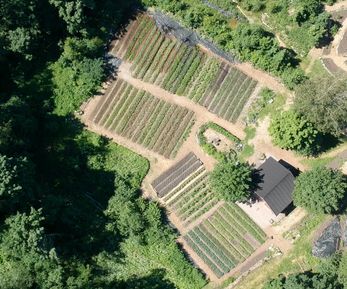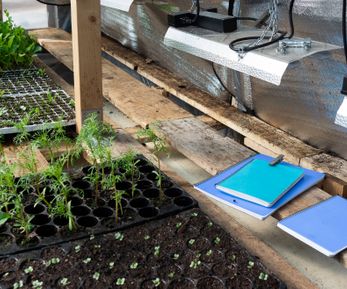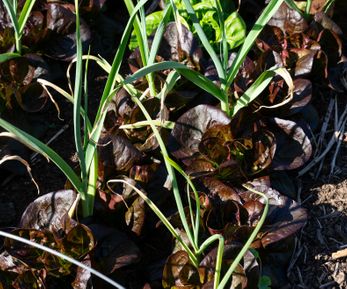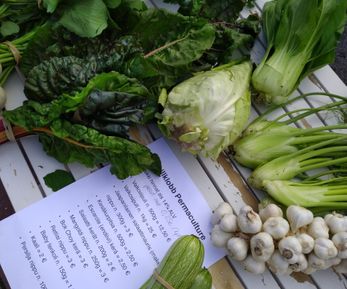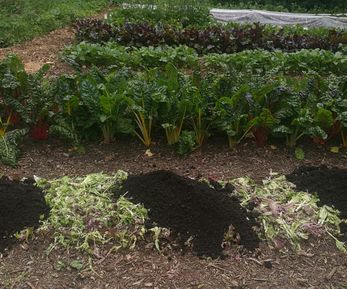Commercial Side:
In Depth
On this page you'll find more about my implementation of agroecology, soil health, and other principles at Lillklobb in the pursuit of "regenerative agriculture"
I understand that those terms are a black box to many people, which is why I've decided to make a page dedicated to explaining them. These ideas are bandied about often these days with the understandable interest that they've garnered. But what did they mean on my farm? These ideas aren't that hard to understand. Consumers have the right to know so they can make better decisions. Want even more? Check out an educational opportunity!
LILLKLOBB WAS FUNDAMENTALLY DIFFERENT
I didn't grow up farming: my interest was sparked during my university days. I've always looked at agriculture as a topic that only makes sense if it is grounded in the ecological reality born from the hundreds of millions of years worth of evolution of life here on earth. We have learned so much, yet the application of this knowledge lacking. To me, it has never been about yield alone.
Sometimes being a new-comer is an advantage because ossified tradition (dogma) gets in the way of much needed change. The downside is that I've had to "learn everything the hard way, twice."
However, this has allowed me to build on first principles and learn from people who are literally generations ahead of me down the broad regenerative pathway. As such, I've been fortunate to live in an era like ours where such information is so readily available.
I joined the ranks of many other people striving in a similar direction. Tot his day, I try to use the same language to describe the same things and am constantly learning from others, even if their experience and context is vastly different from mine. The power of patterns is real.
The ideas talked about here are in their infancy. There is great disagreement over what the meaning of these ideas should be. One thing that I am certain of is that these ideas are not simply "the way things used to be."
AGROECOLOGY
Agroecology is the understanding that human beings live within a natural world and that many artifacts of our culture are simply the creation of people. Other organisms do not recognize most of the boxes and boundaries we have erected upon this earth and in our minds.
If we want to live in agricultural societies, we need to predicate our actions along the patterns that nature has established over the millenia.
By deliberately combining knowledge from both agricultural science and ecology at large, agroecologists attempt to work with "whole" systems.
At some level, we cannot truly understand what a whole system is, but that should not prevent us from attempting to consider the world at varying levels of complexity.
My farm at Lillklobb was planned after studying global, regional, and local influences ranging from climate to people's land use.
Things were placed where they were because I have considered where to put them.
A well designed "agroecology" (what one might call a system planned with these ideas) will have multiple reasons for the placement of design elements. The patterns are easy to learn. The more of us who decide to change, the easier they will become to implement.
Agroecology also stresses the importance of healthy interpersonal relationships and strives to create a more fair culture for people to thrive in.
SOIL HEALTH
Soil health can be defined in many ways. One of the best definitions I have run across is from the United States Natural Resources Conservation Services which defines soil health as: "the continued capacity of soil to function as a vital living ecosystem that sustains plants, animals, and humans."
Though let's not forget the microbes and fungi either!
The past decade has seen a great effort made to simplify the basic things people need to do for soil health to improve:
1) Minimize Disturbance
2) Keep Soil Covered
3) Increase Diversity
4) Keep Living Roots Growing As Long As Possible
5) Integrate Livestock
Each of these principles may or may not improve soil health when implemented in isolation. When they are combined, the improvements can come rapidly. The sad truth is that most vegetable farms do a poor job of all of the above.
Each principle is simple on the surface in order to provide basic guidelines to anyone living where plants grow. The simplicity of the message, which is basically exhorting us allow nature to work and stop getting in the way, is in part why it has spread so quickly. Focusing on the soil and encouraging people to try, to trust themselves and nature, to think of the bigger picture without casting blame is another.
At Lillklobb, I managed to integrate principles 1-4 into my system and strove to find a way to intregrate livestock in a manner that both works and respects the animals.
1. Minimize Disturbance
3. Increase Diversity
At Lillklobb, the only motor tools at my disposal were a chainsaw, an electric drill, a small wood chipper, and my Volvo. There's no tractor, two wheel or four hooved, to "work" the soil. All of the gardening was done by hand. Although the team used a broadfork for one season, its continued use after getting the job done wasn't required either. Surprisingly it was more effective as a tool to help remove perennial weeds than decompacting the soil. Like many "things" it was very useful for the stage the farm was in.
Disturbing the soil through tillage, cultivation, and chemical applications should be kept to the bare minimum and if it is used at all then the soil needs to be healed immediately with biology.
Did you know that earthworm burrows can last at least 30 years in our climate? Imagine how many tunnels various soil organisms, including plants and fungi, can create to improve soil structure in that amount of time. And imagine the number of homes you destroy and work that is wasted everytime you "work" the soil!
Long term studies looking into the effect of species diversification, including one from Jena, Germany, are revealing what nature has always shown us: diversity is critical to the building of health soil.
Agriculture has largely developed (or been enforced) in our societies along the lines of monocultures. They have obvious benefits, but also quite obvious downsides when employed year after year. Increasing diversity among cash crops, in cover crops, and moving into perennials wherever possible is essential to building soil health. I've routinely grew more than 50 kinds of annual plants per year! Perennial diversity was increasing too.
Humanity is learning more each passing year about the exchange of information and resources between plants, fungi, and soil organisms. Terms like quorum sensing and rhizophagy are the beginnings of our understanding regarding this immensely complicated and busy world we live in and on. We need the courage to act even if it means making mistakes.
2. Keep Soil Covered
You would have been hard pressed to find bare soil on my operation. Whether it is wood chips on paths and even under lawn grass, compost acting as a mulch, or thick diverse cover crops, the soil was never exposed. This is the absolutely most obvious thing anyone can look out for when checking out farms that grow your food.
If you see bare soil, you need to ask the farmer why. There is no long term excuse for leaving soil bare to the elements. Between solar radiation, wind, and precipitation the soil is "starving, naked, and running a fever" according to NRCS specialist Ray Archuleta. I couldn't agree more. Leaving soil bare is a quick way to make dirt.
Be wary of #soilhealth and #regenerativeagriculture attached to posts depicting tilled, bare soil. Don't be afraid to ask farmers why the soil is bare and what they plan to do to correct it.
4. Keep Living Roots Growing As Long as Possible
Although typical cash crops generally need temperatures greater than 10 C to grow, there are plenty of other species which will grow quite happily at lower temperatures. Especially in our climate you find farmers wasting the two most important inputs our farms receive (and for free to boot!): sunlight and water in the form of precipitation. By ensuring that I had diverse green plants out in the field as long as possible, I could rest assured that all of the essential services that begin with photosynthesis were occuring.
The photo behind this text block is a diverse cover sown after the last garlic harvest in 2020. It is loaded with diversity and even managed to feed bees and insects through flowers before the first frosts of the season! No bare ground, no fallow period, no tillage, no erosion. Yes to habitat, to photosynthesis, to diversity, to life.
AGROFORESTRY & MARKET GARDENS
The two main commercial enterprises at Lillklobb were integrated with one another. One cannot escape the fact that Lillklobb is covered in trees. The vast majority of the trees preexisted my work and I needed to implement the market gardens with them in mind.
While the project ended before it could become a fully fledged commercial agroforestry system, the entire property is set within an agroforestry pattern. In addition I had multiple hedgerows that were in different stages of development.
In 2021 I began the first Syntropic Agroforestry lines with apples, plums, and pears as the main crops. Those trees found a new home in 2023.
The hedgerows hugged in all of the market gardens, providing much needed diversity in structure and time so that I had plenty of "good" insects and other organisms around for balance.
A Market Garden's Growing Season in Brief
WANT TO LEARN MORE?
There is only so much I can put online in text! I'll add more as time allows, but reading is never the same as seeing the farm directly. Check out the many different kinds of educational experiences I have on offer to learn more about these systems on a commerical or even personal scale. If I could do it, you can too.
